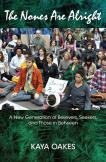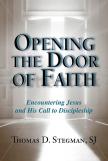The Road to Christ
James Joyce famously wrote in Finnegan’s Wake that “Catholic means ‘here comes everybody.’” Catholics have repeatedly created new forms of community to respond to the signs of the times and the “joys and hopes, griefs and anxieties” of their particular context. In the postmodern West, where we are increasingly isolated and disconnected from each other—experiencing what Robert Putnam in Bowling Alone dubbed a serious “loss of social capital”—questions of building and sustaining community take on a new urgency. This is particularly true for millennials like myself: digital natives who increasingly engage with the world through screens and whose relationships are often formed and deepened through online platforms. What does it mean to be faithful in community in this context?
This question is engaged by Kaya Oakes and Thomas Stegman, S.J., who live on opposite coasts of the United States and write from distinct contexts. Oakes, whose writing has appeared in America, is a self-described “progressive,” “agnostic-leaning believer” and “Catholic revert” (one who was raised Catholic, left and later returned). She teaches at the University of California, Berkeley, “the most secular of secular universities.” Stegman is a Midwest native and New Testament professor at the Boston College School of Theology and Ministry, my alma mater. While many of Oakes’s students and conversation partners are secular, or at least not religious practitioners in any traditional sense, Stegman’s students are training for professional Catholic ministry. It is not surprising, then, that they make different assumptions and come to diverging conclusions about the life of faith.
Oakes invited young seekers on social media to share their stories of “reinventing what it means to ‘be church’ outside of church walls.” In The Nones Are Alright, she paints a sympathetic, thoughtful portrait of this “Generation of Believers, Seekers, and Those in Between” for whom there is “no one way to believe and no one way to belong.”
The interviewees she highlights are “nones” or “unaffiliated,” a category that describes 31 percent of people between the ages of 18 and 29, according to a Pew Forum study in 2012. For previous generations, faith and practice were assumed. In contrast, Oakes and I and her subjects are part of a postreligious generation, in which adherence to a religious tradition is the exception, not the rule. “Many younger people engage in a kind of spiritual mix and match, blending many traditions and adhering strictly to none,” she writes. They are not indifferent to spirituality and in some cases passionately desire to believe and belong, but they cannot reconcile their experience with the church’s teaching on women or sexuality, struggle with doubt or distrust large institutions—a generational trend that is only exacerbated by the mishandling of the crisis produced by sexual abuse by members of the clergy. Yet these “nones,” Oakes assures us, are “mature, self-aware, intelligent and well informed.” And though they eschew traditional religious practice, they still seek community, engage in service and social justice efforts and experiment with spiritual practice, albeit in a casual, syncretic, do-it-yourself kind of way.
Stegman’s book Opening the Door of Faith: Encountering Jesus and His Call to Discipleship—which originated in articles for The Pastoral Review on the Year of Faith—is written as a resource for “groups to study, reflect, and pray together” with the “sincere hope” that it will “’open the door’ into what the New Testament says about faith.” To this end, he includes 10 prayer and reflection questions at the end of each chapter that serve to challenge the reader in exploring the theme of faith more deeply.
Stegman explores what five distinct voices in the New Testament—Matthew, Mark, Luke-Acts, John and Paul—say about faith. He succinctly and accessibly summarizes each of these five biblical authors’ writing on the topic. He concludes that there are four primary themes: encounter with Jesus, call to discipleship and mission, prayer and sacrament, and community of faith. While acknowledging current polarization in the church and the abuse scandal, Stegman, as a New Testament scholar, is more focused on the words of the biblical authors than on the social and religious landscape of postmodern America.
Several times Stegman posits that faith describes God’s fidelity to God’s people; pistis (“faith” or “faithfulness”) is first a divine attribute, which is then followed by the human response. Our faith is the “second act.” This resonates with much of what Pope Francis has stressed in the Year of Mercy: God seeks us out tirelessly and, thus, the church is to be a place of mercy and welcome. This statement stands in counterpoint to the witness of many of Oakes’s interviewees, whose experience of church is uncomfortable at best and inhospitable and alienating at worst. Unlike Oakes’s “nones” on the religious margins, Stegman assumes belief—while recognizing the challenges of Christian discipleship acknowledged in New Testament texts—and assumes participation in faith community.
Around questions of faith and faithfulness, Stegman and Oakes begin and end in different places. Stegman, citing Luke, states that lived faith is “marked by a bold and holy confidence.” For the young seekers Oakes interviewed, faith is a doubt-filled struggle marked with tension and paradox, even contradiction. Stegman appeals to both the authority of biblical authors and the writings of Popes Francis and Benedict XVI, while Oakes’s “self-reliant and free-thinking” interviewees look to their own experience instead of to outside authority in their quest for truth. Stegman wants his readers to walk through the “door of faith” and “hold the door open for others to enter,” while Oakes is convinced the young seekers she writes about are doing just fine in the liminality of the doorway. For Stegman, the life of faith is one of “continual conversion…even heroism,” while Oakes claims that “faith is a tidal motion, an ebb and a surge, a push and a pull.” Stegman cites the biblical authors in emphasizing the primacy of faith community in “following Jesus alongside others” in “’flesh and blood’ interactions,” while Oakes’s nones drift in and out of various communities and often find like-minded seekers online.
A rare point of consonance between Oakes and Stegman is a shared emphasis on concern for the poor and struggle for social justice in the life of faith. Beyond this, the Boston Jesuit and the Berkeley writer make different assumptions, ask different questions and come to different conclusions about what it means to live faith in community.
Their books, read in conversation with each other, prompt some fascinating questions. How is faithfulness to be understood in a way that recognizes both the truth of Scripture and tradition and the 21st-century reality of postreligious United States? How can our universal church of “here comes everybody” cultivate communities of faith in our postmodern and postreligious context? Who defines Catholic identity and gets to decide what it means to be a faithful Catholic, when so many young people are redefining faith in their own image? If Dorothy Day’s words that the “answer to the long loneliness is community” are taken to heart—particularly during this Year of Mercy—then how can parish communities that “open the door of faith” be recreated in ways that connect with “the joys and hopes, the griefs and anxieties” of both Gen-Xers and millennials?
This article also appeared in print, under the headline “The Road to Christ,” in the June 20-27, 2016, issue.









